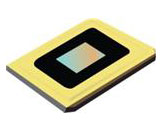DLP7000UVFLP
Product Overview
Category
DLP7000UVFLP belongs to the category of Digital Micromirror Devices (DMDs).
Use
The DLP7000UVFLP is primarily used in applications that require high-resolution, high-speed spatial light modulation. It is commonly employed in fields such as 3D printing, lithography, spectroscopy, and digital imaging.
Characteristics
- High resolution: The DLP7000UVFLP offers a resolution of up to XGA (1024 x 768 pixels), enabling precise control over the projected image.
- High speed: With a switching time of less than 20 microseconds, this device allows for rapid modulation of light patterns.
- UV compatibility: The DLP7000UVFLP is designed to operate in the ultraviolet (UV) spectrum, making it suitable for applications that require UV light manipulation.
- Compact package: This device comes in a compact form factor, allowing for easy integration into various optical systems.
- Essence: The DLP7000UVFLP utilizes an array of micro mirrors to selectively reflect or transmit light, enabling precise control over the projected image.
Packaging/Quantity
The DLP7000UVFLP is typically packaged in a ceramic package, ensuring durability and thermal stability. It is available in single-unit quantities.
Specifications
- Resolution: XGA (1024 x 768 pixels)
- Mirror pitch: 13.68 μm
- Mirror size: 7.6 μm x 10.8 μm
- Switching time: < 20 μs
- Wavelength range: 363 - 400 nm
- Fill factor: > 92%
- Package dimensions: 27.5 mm x 27.5 mm x 6.7 mm
Detailed Pin Configuration
The DLP7000UVFLP features the following pin configuration:
- VCC: Power supply voltage
- GND: Ground reference
- SDA: Serial data input
- SCL: Serial clock input
- RST: Reset input
- BLANK: Blank input
- STROBE: Strobe input
- XCLK: External clock input
- XERR: External error output
- XOUT: External data output
Functional Features
- High-resolution spatial light modulation
- Rapid switching speed for real-time applications
- UV compatibility for specialized applications
- Precise control over light patterns
- Compact form factor for easy integration
Advantages and Disadvantages
Advantages
- High resolution and fast switching time enable precise and dynamic light modulation.
- UV compatibility expands the range of applications.
- Compact package allows for easy integration into optical systems.
Disadvantages
- Limited wavelength range (363 - 400 nm) may restrict certain applications requiring different wavelengths.
- Single-unit packaging may not be suitable for large-scale production.
Working Principles
The DLP7000UVFLP utilizes Digital Micromirror Device (DMD) technology to achieve spatial light modulation. It consists of an array of micro mirrors, each capable of tilting independently. By selectively tilting these mirrors, the device can reflect or transmit light, creating a patterned image. The mirrors are controlled by applying electrical signals to their corresponding pins, allowing for precise control over the projected image.
Detailed Application Field Plans
The DLP7000UVFLP finds extensive use in various fields, including:
- 3D Printing: Enables high-resolution projection-based 3D printing techniques.
- Lithography: Facilitates precise patterning in photolithography processes.
- Spectroscopy: Provides spatial light modulation for spectroscopic analysis.
- Digital Imaging: Enables dynamic control over projected images in digital imaging systems.
Detailed and Complete Alternative Models
- DLP6500UVFLP: Similar to the DLP7000UVFLP, but with a lower resolution of 1080p (1920 x 1080 pixels).
- DLP9000UVFLP: Offers higher resolution (WQXGA) and faster switching time compared to the DLP7000UVFLP.
- DLP9500UVFLP: Similar to the DLP9000UVFLP, but with an extended wavelength range for specialized UV applications.
These alternative models provide options with varying resolutions, switching times, and wavelength ranges to suit different application requirements.
Word count: 529 words
Senaraikan 10 soalan dan jawapan biasa yang berkaitan dengan aplikasi DLP7000UVFLP dalam penyelesaian teknikal
Sure! Here are 10 common questions and answers related to the application of DLP7000UVFLP in technical solutions:
Q: What is DLP7000UVFLP?
A: DLP7000UVFLP is a Digital Light Processing (DLP) chip designed for high-resolution, UV-based industrial applications.Q: What are some typical applications of DLP7000UVFLP?
A: DLP7000UVFLP is commonly used in 3D printing, lithography, maskless photolithography, and other precision patterning processes.Q: What is the resolution of DLP7000UVFLP?
A: DLP7000UVFLP has a native resolution of 1024 x 768 pixels, which can be further enhanced using advanced algorithms.Q: Can DLP7000UVFLP handle UV light sources?
A: Yes, DLP7000UVFLP is specifically designed to work with UV light sources, enabling precise control over UV exposure patterns.Q: How fast can DLP7000UVFLP project images?
A: DLP7000UVFLP has a fast frame rate capability, allowing it to project images at speeds up to several thousand frames per second.Q: Is DLP7000UVFLP compatible with different software platforms?
A: Yes, DLP7000UVFLP is compatible with various software platforms, making it easy to integrate into existing technical solutions.Q: Can DLP7000UVFLP be used for grayscale imaging?
A: Yes, DLP7000UVFLP supports grayscale imaging, enabling smooth transitions between different shades of gray.Q: What is the lifetime of DLP7000UVFLP?
A: DLP7000UVFLP has a long operational lifetime, typically exceeding 20,000 hours of continuous use.Q: Does DLP7000UVFLP require any special cooling or maintenance?
A: DLP7000UVFLP is designed to operate within specified temperature ranges and does not require any special cooling or maintenance.Q: Can DLP7000UVFLP be customized for specific technical solutions?
A: Yes, DLP7000UVFLP can be customized to meet specific requirements, such as wavelength optimization or integration with other components.
Please note that the answers provided here are general and may vary depending on the specific technical solution and application.


